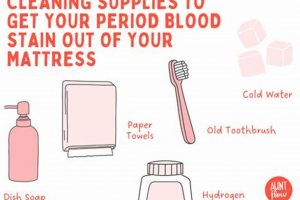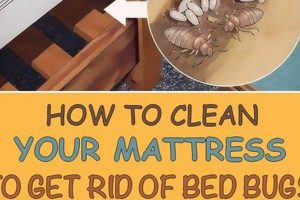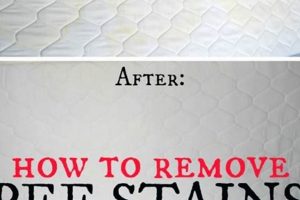The process of removing discoloration and residue resulting from bodily waste incidents on bedding is a common household concern. Addressing these stains promptly and effectively is crucial for maintaining hygiene and preventing lasting damage to the mattress material.
Effective stain removal not only improves the aesthetic appeal of the mattress but also mitigates potential health risks associated with bacteria and odor. Historically, various methods, ranging from simple water and soap solutions to more specialized enzyme cleaners, have been employed to tackle this issue, reflecting an ongoing need for effective cleaning solutions.
The following sections will detail several proven strategies for successfully eliminating these blemishes and restoring the mattress to a clean and sanitary condition. These methods encompass readily available household materials as well as commercially produced cleaning agents, allowing for tailored solutions based on the severity of the staining and the type of mattress material.
Effective Strategies
The following recommendations offer practical guidance for mitigating the impact of urine stains on mattresses, promoting cleanliness and extending the lifespan of the bedding.
Tip 1: Immediate Action: Promptly address the incident. The longer the urine remains on the mattress, the more difficult it becomes to remove, increasing the likelihood of permanent staining and odor retention.
Tip 2: Absorbent Materials: Utilize absorbent materials such as paper towels or clean cloths to blot the affected area. Apply firm pressure to draw out as much liquid as possible. Repeat this process until minimal moisture is transferred to the absorbent material.
Tip 3: Cold Water Rinse: Sponge the stained area with cold water. Avoid hot water, as it can set the stain. Lightly dampen the area and continue blotting to lift the stain. Do not saturate the mattress.
Tip 4: Baking Soda Application: Generously apply baking soda to the affected area. Baking soda is a natural deodorizer and helps to absorb remaining moisture and odor. Allow the baking soda to sit for several hours, or ideally overnight.
Tip 5: Vacuum Removal: After the baking soda has dried, thoroughly vacuum the area to remove the residue. Use an upholstery attachment to ensure complete removal of the baking soda particles.
Tip 6: Enzyme Cleaner Application: Consider using an enzyme-based cleaner specifically designed for pet stains. These cleaners contain enzymes that break down the uric acid crystals, effectively eliminating the source of the odor. Follow the manufacturer’s instructions carefully.
Tip 7: Thorough Drying: Ensure the mattress is completely dry before replacing bedding. Use a fan or open windows to promote air circulation and accelerate the drying process. Moisture trapped within the mattress can lead to mold growth.
Consistent application of these strategies will significantly reduce the visibility and odor associated with urine stains, maintaining a cleaner and more hygienic sleeping environment.
The next section addresses preventative measures to minimize the occurrence of such incidents and prolong the cleanliness of the mattress.
1. Prompt Action
The efficacy of any method aimed at resolving urine stains on mattresses is intrinsically linked to the immediacy of the response. Delayed action permits the urine to penetrate deeper into the mattress fibers, resulting in a more tenacious stain and a more pronounced odor. The longer the urine remains untreated, the greater the likelihood of permanent discoloration and bacterial growth within the mattress core.
Consider the scenario of a child wetting the bed during the night. If the incident is discovered and addressed immediately upon waking, blotting the area and applying a suitable cleaning agent will typically yield satisfactory results. Conversely, if the wetness goes unnoticed for several hours, or even overnight, the urine will have ample time to soak into the deeper layers of the mattress, making complete removal considerably more challenging. This illustrates the cause-and-effect relationship between response time and the ultimate success of stain removal efforts.
In conclusion, swift intervention is a critical component of any successful strategy. Procrastination in addressing urine stains allows for increased stain penetration, complicating the cleaning process and potentially leading to irreversible damage. The prompt application of absorbent materials and appropriate cleaning solutions offers the best opportunity to minimize the long-term consequences of such incidents, preserving the hygiene and longevity of the mattress.
2. Effective Absorbents
Effective absorbents are fundamental to the successful removal of urine stains from mattresses. Their primary function is to draw out as much liquid as possible before it penetrates deep into the mattress fibers. The choice of absorbent material directly impacts the quantity of urine extracted, thus influencing the severity of the residual stain and odor. For instance, using highly absorbent materials like thick paper towels or dedicated cleaning cloths allows for greater liquid uptake compared to less absorbent alternatives, leading to a less pronounced stain.
The application of baking soda represents another crucial use of absorbents. Baking soda’s porous structure allows it to draw out remaining moisture and encapsulate odor molecules. The longer it remains in contact with the affected area, the more effective it is in neutralizing the urine. Vacuuming after the application of baking soda is critical to remove all residue, preventing potential skin irritation or allergic reactions. Failure to utilize efficient absorbents during the initial stages of stain removal can result in a persistent odor and discoloration, necessitating more aggressive and potentially damaging cleaning methods.
In summary, the selection and application of effective absorbents is a critical determinant in the overall success of stain removal. Utilizing appropriate materials, combined with prompt and thorough application, minimizes the extent of staining, reduces the intensity of lingering odors, and simplifies subsequent cleaning efforts. Effective absorbance serves as a foundational step in the comprehensive process, directly impacting the outcome of efforts to eliminate urine stains from mattresses.
3. Correct Cleaning Agents
The selection of appropriate cleaning agents directly correlates with the successful removal of urine stains from mattresses. Employing the wrong type of cleaner can prove ineffective, potentially exacerbate the stain, or even damage the mattress material. Therefore, a deliberate and informed approach to choosing a cleaning agent is paramount.
- Enzyme-Based Cleaners
Enzyme-based cleaners are specifically formulated to break down the uric acid crystals present in urine. This enzymatic action neutralizes the odor at its source, unlike conventional cleaners that merely mask the smell. These cleaners are particularly effective on older, more deeply embedded stains. However, strict adherence to manufacturer instructions is crucial to prevent potential discoloration or material degradation.
- Hydrogen Peroxide Solution
A 3% hydrogen peroxide solution can be effective on fresh urine stains, acting as a mild bleaching agent. The solution should be applied sparingly to avoid saturating the mattress and followed by thorough blotting. Hydrogen peroxide is best suited for lighter-colored mattresses, as it may cause lightening on darker fabrics. A spot test in an inconspicuous area is always recommended prior to widespread application.
- Baking Soda Paste
A paste made from baking soda and water provides a gentler cleaning alternative. Baking soda’s alkaline properties help neutralize the acidic components of urine. The paste should be applied to the stain, allowed to dry completely, and then vacuumed away. While less aggressive than enzyme cleaners or hydrogen peroxide, baking soda is a suitable option for delicate mattress materials or for individuals sensitive to stronger chemicals.
- Vinegar Solution
A solution of equal parts white vinegar and water can also be employed. Vinegar’s acidity helps to break down urine stains and neutralize odors. The solution should be applied lightly and blotted thoroughly. Vinegar is a cost-effective and readily available option, but may leave a temporary vinegar smell, which dissipates as the mattress dries.
The selection and application of appropriate cleaning agents are critical determinants in the successful removal of urine stains. Each option possesses unique characteristics and is best suited for specific situations. Informed decision-making, coupled with careful application, significantly increases the likelihood of complete stain and odor removal, preserving the integrity and hygiene of the mattress.
4. Thorough Stain Removal
The process of completely eliminating urine stains from a mattress is intrinsically linked to the success of any remediation effort. The extent to which the stain is removed directly affects the overall hygiene and usability of the mattress. Incomplete removal leaves behind residual components, fostering bacterial growth and perpetuating unpleasant odors. This underscores the necessity for diligent and methodical stain removal techniques.
Consider a scenario where surface-level cleaning is performed without addressing the deeper stain penetration. While the visible discoloration may be reduced, the underlying urine residue persists within the mattress fibers. This leads to the gradual reappearance of the stain and the emission of a lingering odor, especially in humid conditions. In contrast, a rigorous approach involving enzyme cleaners that break down uric acid crystals, followed by thorough blotting and drying, yields a significantly more favorable outcome, effectively eradicating the source of the stain and odor.
In summary, thorough stain removal is not merely an aesthetic concern; it is a fundamental aspect of mattress sanitation. Achieving complete stain elimination requires a multifaceted approach that includes appropriate cleaning agents, meticulous application techniques, and a commitment to addressing all traces of urine residue. A superficial cleaning will ultimately prove insufficient, while a comprehensive strategy will result in a clean, sanitary, and odor-free mattress.
5. Complete Odor Neutralization
Complete odor neutralization constitutes a critical phase in the process of addressing urine stains on mattresses. While visible stain removal may improve the mattress’s aesthetic appearance, the persistence of urine odor indicates the continued presence of residual organic compounds. These compounds, primarily uric acid crystals, are the root cause of the characteristic smell and can attract bacteria, thereby compromising the mattress’s hygiene. Therefore, successful stain removal inherently necessitates complete odor neutralization to achieve a truly clean and sanitary outcome.
The relationship between urine stain removal and odor neutralization is causal. Effective stain removal techniques, such as enzymatic cleaning, directly target the odor-causing uric acid crystals, breaking them down into odorless compounds. Conversely, methods that solely focus on stain appearance without addressing the underlying odor sources, such as surface cleaning with water alone, provide only temporary relief. For instance, a mattress may appear visually clean after being treated with a general-purpose cleaner, but the distinctive urine odor may reappear, especially in humid conditions, indicating incomplete neutralization. In such cases, specialized odor neutralizers, like baking soda or enzyme-based products, are required to fully resolve the issue.
The comprehensive process of mattress restoration demands both stain and odor elimination. Achieving this requires understanding the specific characteristics of urine composition and selecting cleaning agents that effectively target those components. Complete odor neutralization, therefore, is not merely a desirable outcome; it is an essential component of effective mattress cleaning. By addressing both the stain and the odor simultaneously, individuals can ensure a clean, hygienic, and comfortable sleeping environment.
6. Preventative Measures
The correlation between preemptive strategies and the need for stain removal interventions is direct and significant. Proactive measures designed to protect mattresses directly reduce the frequency and severity of urine stains, thereby diminishing the necessity for complex cleaning procedures. Implementing safeguards before incidents occur minimizes the opportunity for urine to penetrate mattress fibers, decreasing the likelihood of persistent stains and odors. This proactive approach represents a fundamental component of maintaining mattress hygiene and extending its lifespan.
Consider the use of waterproof mattress protectors. These barriers effectively shield the mattress from accidental spills and bodily fluids, preventing direct contact and subsequent absorption. For example, in households with young children or individuals prone to incontinence, utilizing a waterproof mattress protector can significantly reduce the occurrence of urine-related incidents. The protector, being easily removable and washable, bears the brunt of the incident, leaving the mattress pristine. Without such protection, urine would saturate the mattress, necessitating extensive cleaning efforts and potentially resulting in permanent damage.
In conclusion, prioritizing preventative measures is paramount in mitigating the need for intensive stain removal processes. The adoption of proactive strategies, such as waterproof mattress protectors and consistent hygiene practices, directly contributes to preserving the integrity of the mattress and minimizing the challenges associated with urine stains. The understanding that prevention is more efficient and cost-effective than remediation is key to maintaining a clean and sanitary sleeping environment.
Frequently Asked Questions
This section addresses common inquiries regarding the removal of urine stains from mattresses. The information presented aims to provide clarity and guidance on effective cleaning methods.
Question 1: Is immediate action truly necessary when dealing with urine stains?
Prompt response is crucial. The longer urine remains on a mattress, the more deeply it penetrates the fibers, increasing the difficulty of stain and odor removal. Delayed action can lead to permanent damage and bacterial growth.
Question 2: What type of absorbent material is most effective for urine stain removal?
Highly absorbent materials, such as thick paper towels or dedicated cleaning cloths, are recommended. These materials facilitate maximum liquid uptake, reducing the severity of the stain. Baking soda is also effective for absorbing residual moisture and odors.
Question 3: Can heat, such as from a hairdryer, be used to speed up the drying process?
Applying direct heat is generally discouraged. Heat can set the stain, making it more difficult to remove. It is preferable to use fans or open windows to promote air circulation and natural drying.
Question 4: Are enzyme-based cleaners always the best option for removing urine stains?
Enzyme-based cleaners are highly effective due to their ability to break down uric acid crystals. However, it’s crucial to follow manufacturer instructions carefully. Additionally, a spot test in an inconspicuous area is recommended to prevent discoloration or damage to the mattress material.
Question 5: How can one be certain that all of the baking soda has been removed after application?
Thorough vacuuming is essential. Utilize an upholstery attachment to ensure the complete removal of baking soda particles from the mattress surface. Multiple passes may be necessary to eliminate all residue.
Question 6: Is professional mattress cleaning recommended for severe or old urine stains?
For severe or deeply embedded urine stains, professional mattress cleaning is often advisable. Professional services possess specialized equipment and cleaning agents that can effectively address stubborn stains and odors, potentially restoring the mattress to a clean and sanitary condition.
These FAQs offer guidance on addressing urine stains on mattresses. Implementing these recommendations increases the likelihood of successful stain and odor removal.
The next section will present a summary of the key points discussed in this article.
Conclusion
The preceding analysis has explored the critical steps involved in addressing the issue of how to get urine stains out of mattress effectively. The importance of immediate action, the utilization of effective absorbents, the selection of correct cleaning agents, the execution of thorough stain removal techniques, the necessity of complete odor neutralization, and the implementation of preventative measures were all examined. Each element contributes to a comprehensive strategy for mattress restoration and hygiene maintenance.
The successful application of these guidelines directly impacts the longevity and sanitation of mattresses. Consistent implementation of these best practices ensures a cleaner, healthier sleeping environment. Ignoring these principles can lead to persistent odors, bacterial growth, and irreversible damage. Therefore, the diligent pursuit of these methods is essential for responsible mattress care.







